Any pet owner would be concerned about how hard it is to clean up after their pet, so knowing whether it can be trained to use a litter box or not is a critical piece of knowledge.
Pig litter boxes have to come in all shapes and sizes, baby pigs can easily use litter trays but as they get bigger and heavier you have to be more creative by modifying plastic kiddie pools or coming up with a DIY alternative.
This article will guide you through the process of choosing the right litter and knowing what factors to consider, as well as help you in effectively potty training your pet pig.
Pigs can be trained to use litter boxes, but they may need something different than just your average cat litter box. The good news is, there are a lot of materials readily available for you to provide your pig with its own litter box.
Pig Litter Box Basics
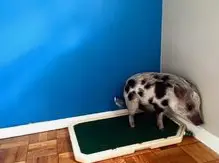
Let’s start with the basics.
Where to Put It
If you plan on indoor potty training, you’re going to have to provide enough litter boxes around the house especially if your pig hasn’t reached its 6th month yet. Piglets are prone to accidents, so the more litter boxes you have at home, the better.
Better yet, choose a single spot where there’s enough space. While potty training, you’re going to need as much space as you can around the litter box, so you can’t put this near a hallway or any other spot where there’s a lot of activity going on.
Make sure this spot is easy to reach as well. You’d have to give your pig a lot of support in the beginning, so you need space to move around and place it in the litter box as necessary.
You may want to check for privacy as well. Some pigs get shy if you let them do their business in public.
Cleaning Your Litter Box
Cleaning your pig’s litter box can be quite a challenge, especially when you get whiff of the smell of pig urine. Pig urine has high ammonia content, which can really hurt your nose. This is why you can’t just use regular dog or cat cleaners from the pet store.
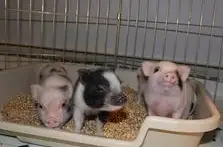
Clean your litter box as often as possible. You can tell if there’s a need to scoop up the litter by the smell of it. Don’t let it get to a point where you can’t even approach the area without gagging because of the strong smell.
You also have to remember that the required frequency in changing the litter and cleaning the box would also depend on the kind of litter you use. The different kinds of litter you can use as well as how good they are in absorbing urine will be discussed later on in this article.
Don’t forget about cleaning the entire area around your litter box as well. Look for cleaners that eliminate ammonia. This is usually stated on the label. Enzyme cleaners usually work best if they break down the urine or feces’s organic compounds instead of merely covering the smell.
You can also make your own water and vinegar mixture.
In case your pig made a mess on your carpet, just soak the area with carpet cleaner, then cover the area with baking powder. Leave that overnight, then vacuum over the area the next day.
Kinds of Litter
There are a lot of kinds of litter available that you can choose from, each of them having their fair share of pros and cons. There are also a number of options that you should not take at all, and for very good reasons.
What to Use
These can be found in pet stores, but they would usually be cheaper in farm stores. There are a lot of brands available, and the price would be range from $5 to $7 for 40 lbs.
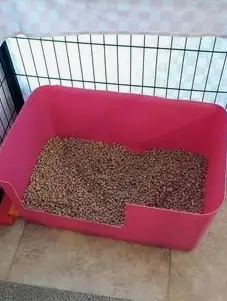
Some people would find the scent it gives off to be nice, which is enough to cover the smell of your pig’s urine. These are also highly absorbent and would always keep your pig’s feet dry. The best part of it is because it’s natural, it’s good enough to be composted.
There would still be some people who would feel like the smells reminds them of a barn, so it could be an acquired scent. The pellets also turns to powder sometimes, making it harder to scoop out.
- Newspaper Pellets
These are made of recycled paper and can be bought at pet stores. You can get them at less than $12 for 25 lbs.
If you’d rather use odorless pellets, then this is perfect for you. They are absorbent and can also keep your pig’s feet dry. They also don’t break down as easily when they get wet. This makes cleaning up the litter box a lot easier.
Compared to other options, this is a bit more expensive. Your litter box will also turn really smelly noticeably faster, because it doesn’t have any odor or scent that could mask the smell of your pig’s urine.
You can get pine shavings at pet stores, tractor supply stores, farm stores, and at Walmart. If you want them cheap, better go to a feed store as these usually sold at only around $6 for a huge bag.
You can buy these everywhere, and they’re a lot cheaper than your other options. It’s an environment-friendly option too, because this can also go right into your compost.
However, there may also be a number of problems in using this as litter. Because pigs love rooting, the appearance and texture of pine shavings can cause them to just scatter the shavings all over the place. They aren’t as absorbent as pellets either, so your pig may find it uncomfortable when their hooves get wet.
- Newspapers
Some owners may opt to use old newspapers lying around. After all, this is not only cost-effective, it’s an environment-friendly choice as well.
However, newspapers have very little absorbent powers and would only leave your pigs with wet feet,, making them uncomfortable to pee in the litter box.
You can get puppy pee pads at farm stores, pet stores, and at Walmart. If you want better value for your money, better get them in bulk from Amazon or eBay.
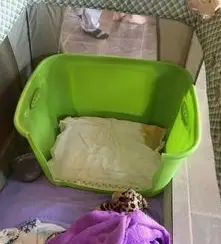
These are great if you travel around because it is extremely lightweight. There’s no need to scoop anything out, either. You can also notice quite easily if your pig’s urine is a little off-color, alerting you effectively about potential health problems.
Despite the convenience that pee pads bring, the fact still remains that they are harmful to the environment in the long run. Some pigs may also try to wreck the pad and could ingest the materials, which could cause some problems. You would also have to change the pad after every use, so it can also get very expensive over time.
What to Avoid
Just as there are recommended materials, there are also a few litter options that you should stay away from.
Don’t use clay cat litter because pigs may end up ingesting the material, which could cause a blockage in their intestines. You may also risk dust inhalation for your pig, or they may end up with the material getting stuck in their snout.
Corn cob litter, walnut litter, and cedar pellets and shavings are also harmful to your pig, especially when accidentally ingested.
Litter Box Ideas You Can Use
There are a lot of things you can use as your pig’s litter box. Here are just some of them:
- A kiddie pool
- A Rubbermaid tub
- A dog crate tray
- A water heater drip pan
- Any multi-purpose tub from Home Depot
- A rabbit droppings pan
- A cat litter box (you can either go for a shallow one or a covered one)
- A plastic tote (just cut out a hole for the entrance)
There are litter-free potty systems that you can purchase as well. These are mostly meant for dogs, but pigs can use them just as much. This allows you to save up on costs, basically because you don’t even have to buy litter. You won’t have to worry about throwing litter out and harming the environment, too.
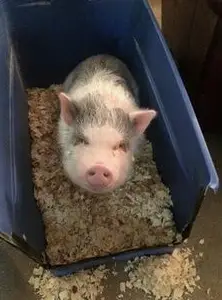
The biggest problem with litter-free options is that it has to be big enough to catch all of a pig’s urine (yes, they can send out a pee flood). There’s also no option for odor control.
Potty Training Your Pet Pig
There isn’t really a solid rule on where your pig should be trained to go potty. It is usually a matter of preference. However, it is also highly recommended that you teach your pig a combination of both.
Let’s discuss the different factors surrounding outdoor and indoor potty training so that you can understand how to go about it.
Indoor Potty Training
Indoor potty training is ideal for two conditions — when you have a really young piglet, and when it’s cold outside.
Young piglets still have very little control over their bladder. When they have to go, they have to go. This means that more often than not, they won’t have the chance to even step out of the door before their urine comes out.
They also urinate more often than any other pig.
Outdoor potty training can also be a problem during the cold winter months, regardless if you have a young piglet or a full-grown pig.
Here are some tips for effective indoor potty training:
- Ask your breeder what materials they used for your pig’s litter and use the same thing. Even if you plan on transitioning to a different kind of material later, you still get optimal results when you start your pig off with something familiar.
- Make sure you keep your pig in a small enclosed area so that your pig can easily reach the litter box anytime they need to go. Just make sure there is still some distance between the litter box and the pig’s sleeping and eating area. Contrary to what you’ve been hearing your entire life, pigs are actually clean animals and do not like it when there’s dirt around the area where they sleep and eat.
- Ensure that the area where the potty training is held will be the permanent spot for the litter box. Your pig will remember the spot, and not just the litter box. So if you move the litter box elsewhere, they will keep going back to the same spot to urinate and poop even if there’s no litter there.
- Place your pig in the litter box after they eat or after they drink, then give the command, “Go potty.” You can also do this at different times throughout the day. When they do end up urinating or pooping in the litter box, give them a treat as a reward so that they know they did the right thing. Don’t forget to say, “good girl” or “good boy” as well. You can lessen the treats as they start mastering the habit.
- Start widening the amount of space around your pig as it masters the use of the litter box. The moment it misses the litter box and ends up making a mess on the floor, make the space smaller again. This will help the pig understand the consequences of not using the litter box properly.
- Don’t make it challenging for your pig to use the litter box. Although the sides should be high enough to keep their urine from spilling outwards, you should cut a walk-in entrance that makes it easy for your pig to go in and out. Make sure they don’t slip as well, as this can traumatize them and keep them from using it. You can use paper towels as lining at the bottom of your litter box to give additional traction.
- Avoid letting them roam around the house while they’re still mastering the art of using the litter box. This will make them distracted and could make them forget that they’re supposed to go back to their corner to urinate or poop.
Choose your potty training corner well. Be especially careful of the carpet. Even if you’ve cleaned the pig urine out countless times, the pig will still be able to sniff a whiff of it and will attempt to make a mess on the same spot again.
Outdoor Potty Training
Don’t let your pig wander around freely especially when potty training. Have an enclosed outdoor area, or keep your pig on a leash and harness while it goes potty.
When do you take them out to potty?
Do this after they eat, after they drink, after waking up (even from naps), or during playtime.
Choose the right command words as well. You can say “go potty”, then say “good boy” or “good girl” when they follow your command. Treats are also great, but transition away from it when you notice that your pig is already picking up the habit.
Provide an easy way for your pig to go outdoors as well, especially when it’s officially potty-trained. You can either install a doggie door for them, or teach them to ring a bell that you can install near the door whenever they need to go out.
Important Potty Training Reminders
- Always remember that training a piglet is like teaching a baby. Although it’s still young, it would take repeated and consistent effort to really make your mark.
- Don’t result to punishment or screaming. This has never helped in training any pet. Worse, it may end up traumatizing your pet and may affect the effectiveness of your training negatively.
- It’s best to put puppy pads or towels around the litter box because there will be times when your pet pig won’t be able to make it into the box in time. This way, you won’t have to worry too much about cleaning up any additional mess made.
- Be attentive to the way your pig behaves in the entire course of potty training. If you noticed that they refuse to use the litter box and keep squeezing under a chair or a table to do their business, then it’s possible that they want privacy while they pee. In this case, you can provide a covered litter box instead.
- Your pig’s hormones can also affect its potty training. Pigs in heat will attempt to leave their scent everywhere in the hopes of attracting a mate. Have your pig neutered (for male pigs) or spayed (for female pigs) to avoid this.
Related Questions
Can a pig be house broken?
Pigs can be easily house broken, sometimes even faster than dogs. They are highly intelligent creatures that have amazing memories, making them the best students for training. You can teach them to obey basic skills like sitting, standing and staying, as well as discipline and proper behavior.
What gets rid of the smell of a pig’s urine?
Look for commercial cleaners that can get rid of ammonia, and not just the usual pet cleaners. Pig urine smells bad because of its high ammonia content. If you’d rather make your own cleaner, a mixture of white vinegar and cold water should do the trick. For best results, soak the affected area with the vinegar solution for about 10 minutes before cleaning it all off.
Do pet pigs smell?
Despite its reputation, pigs themselves do not release any bad odor. They are actually among the cleanest animals of all, as long as they are given the right kind of environment that allows them to stick to their true nature. When they are in heat however, male pigs could excrete a smelly substance from their penis, while female pigs urinate everywhere despite having been trained to use the litter box. This can be solved by neutering / spaying.
Images in this article courtesy of Pinterest
